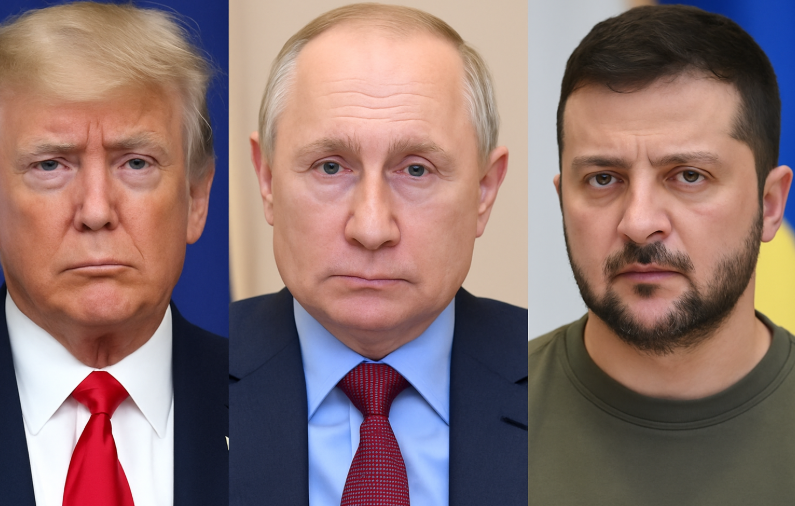Trump Seeks Russia-Ukraine Ceasefire:The geopolitical landscape in 2025 is marked by overlapping crises and shifting alliances. The Russia-Ukraine war has dragged on for over three years, testing international resolve and reshaping European security dynamics. In Asia, Taiwan faces mounting pressure from China, not only militarily but also through potential economic blockades targeting its energy and semiconductor industries.
Trump Seeks Russia-Ukraine Ceasefire, Eyes Taiwan Strategy
With the Russia-Ukraine war now lasting over three years, diplomatic movement appears to be gaining momentum. U.S. President Donald Trump is reportedly preparing for his first in-person meeting with Russian President Vladimir Putin since 2019, a potential turning point in a conflict that has cost Ukraine heavily in lives, land, and economic stability. According to Fox News, the meeting could take place at the end of next week, though the location remains unconfirmed. The fact that a one-on-one discussion is even being considered signals that Trump believes Putin may be ready to make some form of concession.
Trump Seeks Russia-Ukraine Ceasefire:For Trump, the immediate priority in talks with Putin is to stop the nightly barrage of Russian cruise missiles, ballistic missiles, and drone strikes that have targeted Ukrainian cities and civilian areas indiscriminately. Ending these attacks would be a first step toward framing a longer-term deal, something Trump has already discussed with Ukrainian President Volodymyr Zelenskyy. Observers believe both sides now understand each other’s positions, and the focus will shift to whether Putin is prepared to agree to the conditions Trump insists upon.
Trump Seeks Russia-Ukraine Ceasefire:A significant sticking point is territory. Bloomberg has reported that Russia intends to keep the land it has seized, including Crimea and about 22% of Ukraine’s territory. Experts say Zelenskyy might be able to acknowledge Russian control temporarily without changing the Ukrainian constitution, which legally prevents ceding sovereign land without a public referendum. Any permanent constitutional change would be politically impossible, given the enormous sacrifices Ukraine has made. Since the war began, Ukraine has endured a devastated economy, hundreds of billions of dollars in infrastructure damage, and immense human loss. Many in Kyiv believe any temporary ceasefire agreement must leave the door open for reclaiming lost land in the future, particularly in a post-Putin scenario.
Trump Seeks Russia-Ukraine Ceasefire:The path to an agreement is complicated by recent remarks from former Russian President Dmitry Medvedev, who has been closely aligned with Putin for decades. Medvedev’s provocative comments about annexing Ukrainian regions were viewed as going too far and as disrespectful toward Trump. Trump responded with sharp rhetoric, including nuclear deterrence language, a move that some analysts believe forced Putin to reassess his negotiating position. The perception is growing that Trump is asserting the U.S. as the “big country” in these talks, dictating terms rather than reacting to Russian moves.
Trump Seeks Russia-Ukraine Ceasefire:Even as the U.S. works on resolving the conflict in Eastern Europe, attention is also fixed on East Asia, where tensions between China and Taiwan remain high. Trump’s administration has conducted war games to examine potential Chinese strategies against Taiwan. Experts warn that Taiwan is highly vulnerable to both direct military invasion and to economic warfare, which may be the more likely path China would take. A key vulnerability is Taiwan’s dependence on imported energy. China could disrupt or block energy supplies, undermining Taiwan’s economy and threatening the global semiconductor supply chain, in which Taiwan is a critical player through its advanced chip manufacturing.

Trump Seeks Russia-Ukraine Ceasefire:The war games have focused on ensuring Taiwan can receive liquefied natural gas (LNG) shipments from the U.S. in the event of Chinese interference. Another strategic dimension is China’s heavy reliance on oil imports from Iran and Russia. Should tensions escalate into a full-blown confrontation, the U.S. could move to cut off Chinese oil and LNG supplies not only from those two countries but also from Qatar and other Middle Eastern suppliers. In such a scenario, Trump’s strategy would likely involve reassuring allies, ensuring they purchase American energy, and securing shipping lanes for Taiwan.
Trump Seeks Russia-Ukraine Ceasefire:In the Middle East, a separate flashpoint is developing in Gaza. Israel’s security cabinet has approved a plan to fully occupy the Gaza Strip, a move driven by the goal of preventing Hamas from regaining control. Prime Minister Benjamin Netanyahu has suggested that Arab neighbors should eventually govern Gaza instead. However, Israeli military officials have expressed doubts about the practicality of the mission. Currently, Israel controls about 30% of Gaza, but expanding control would put significant strain on military resources, especially while hostages remain in captivity. Without an outlet for displaced civilians — such as relocation to Egypt — the occupation could trigger a worsening humanitarian crisis.
Trump Seeks Russia-Ukraine Ceasefire:Trump’s approach to the Gaza situation reportedly involves rallying the United Arab Emirates, Saudi Arabia, the Gulf Cooperation Council, and other Arab states to take on both the financial burden and the eventual governance of Gaza. The aim is to create a coordinated administration plan that satisfies both Israeli security needs and regional stability goals. Analysts believe the sooner such an arrangement can be reached, the better, as Israel faces a challenging and uncertain path if it proceeds alone.
Trump Seeks Russia-Ukraine Ceasefire:From Ukraine’s battlefield stalemate to Taiwan’s strategic vulnerabilities and Gaza’s governance crisis, Trump’s foreign policy is placing economic influence at the center of global diplomacy. His strategy blends sanctions, trade leverage, and security guarantees to bring conflicting parties to the table. Whether this approach will yield lasting agreements remains to be seen, but the coming weeks could prove decisive in shaping the course of multiple international conflicts.
This article is based on publicly available news reports, expert commentary, and official statements at the time of writing. Geopolitical situations are fluid, and developments may change rapidly. The views expressed by quoted individuals are their own and do not necessarily reflect the position of this publication.

